|
|
| Adineta tuberculosa Janson 1893 |
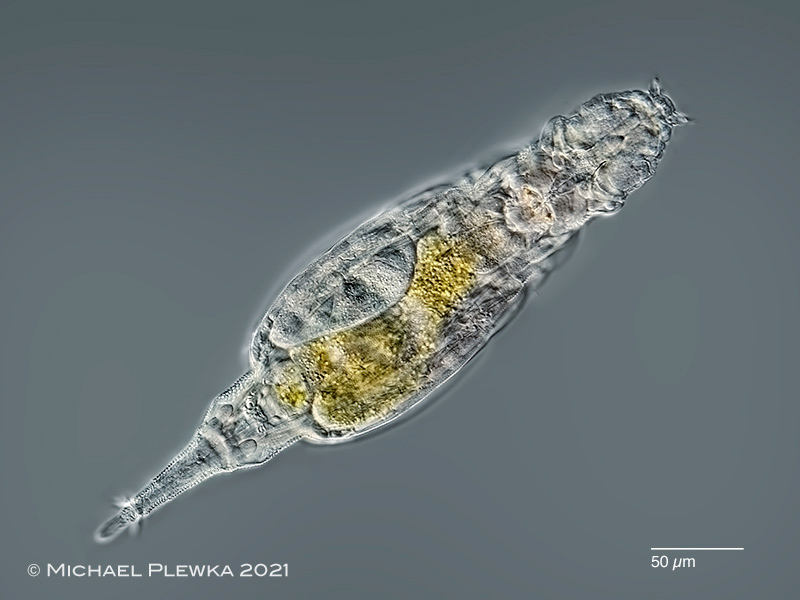 |
| Adineta tuberculosa, dorsoventral view of a creeping/ feeding animal from (3) |
| |
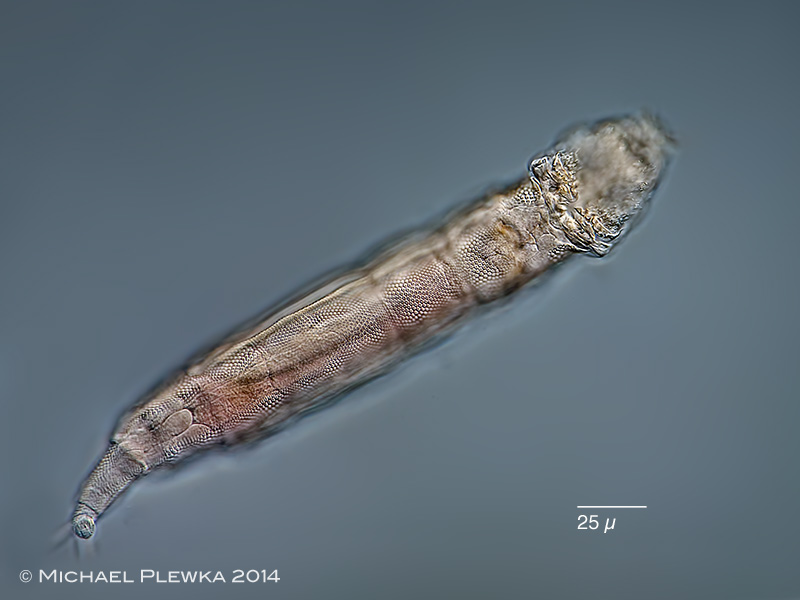 |
| Adineta tuberculosa, ventral view of a creeping/ feeding animal, focal plane on the wart-like integument, which covers the whole animal in this morphotype. This is in contrast to the original description of Janson (1893) whose specimens had no granulations of the integument of the foot. This is also in contrast to the morphotype Adineta sp. 4, where the integument of the trunk has no conspicuous granulations (and the NoUH is different). (1) |
| |
|
| Adineta tuberculosa, anterior part of a specimen from (3), dorsoventral view. Lower right image: macerated specimen showing the pattern of the projections of the integument. Other 5 images: series of 5 optical sections of the anterior part from dorsal to ventral. Upper left: dorsal view, focus plane on the dorsal antenan (DA). Upper right: dorsal view, focus plane on the ridge, which is an elevation of the head pseudo-segment. Mid left: optical secion; ventral view; focus plane on the buccal tube. The arrowheads mark the dorsal head retractor muscles. Mid right: optical section, ventral view; focus plane on the rostrum lamella lRL) and the sensory bristles (SB). The arrowheads mark structures that may be the base of the sensory bristles. The asterisks mark some of the hypodermis cells which are dorsal of the ciliary field. Lower left: ventral view, focus plane on the ciliary field and rake apparatus. (3) |
| BF: buccal funnel; Br: brain; BP: basal plate of the rake apparatus; BT: buccal tube; DA: dorsal antenna; HS: head pseudo-segment; NS 1: 1st neck pseudo-segment; NS 2: 2nd neck pseudo-segment; NS 3: 3rd neck pseudo-segment; Mx: mastax with ramate trophi; Ro: rostrum; lRL; rRL: left and right rostrum lamella; lSB; rSB: left and right sensory bristles; St: sting; Tr: trunk |
| |
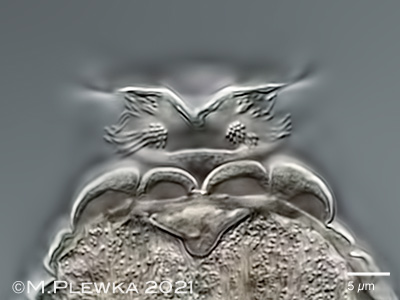 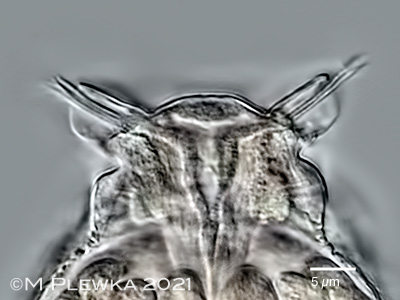 |
| Adineta tuberculosa, two images of the rostrum lamella of the same specimen, which demonstrate how different the rostrum looks like depending on the inclination of the rostrum to the substrate (or the optical axis of the microscope lens). Left image: focus plane on the sensory bristles in top view and the arcuate upper lip . Right: crop of the above image with sensory bristles and structures that connect to the brain.(3) |
| |
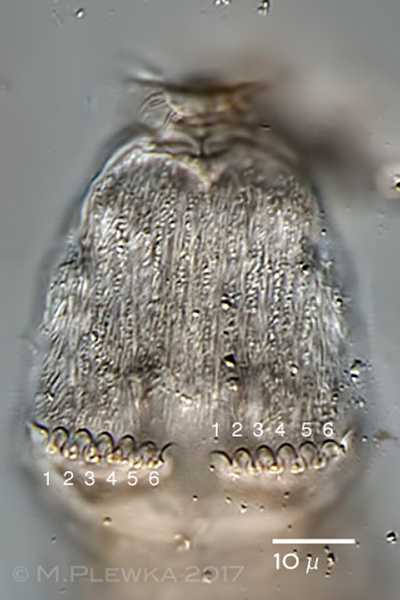 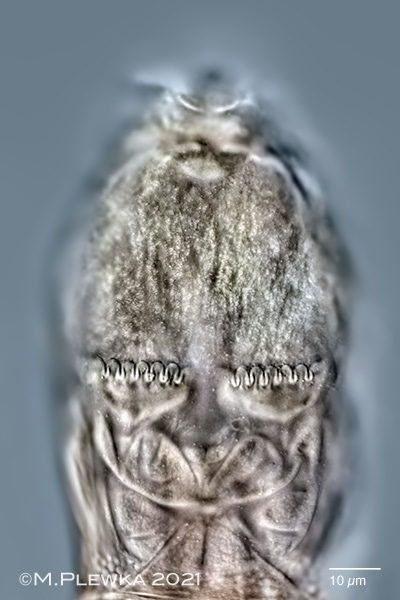 |
| Adineta tuberculosa, focus plane on the ciliary field and the prehensile apparatus (rake apparatus); rakes with 6 U-hooks on each side. Left: (1) ; right: (3). |
| |
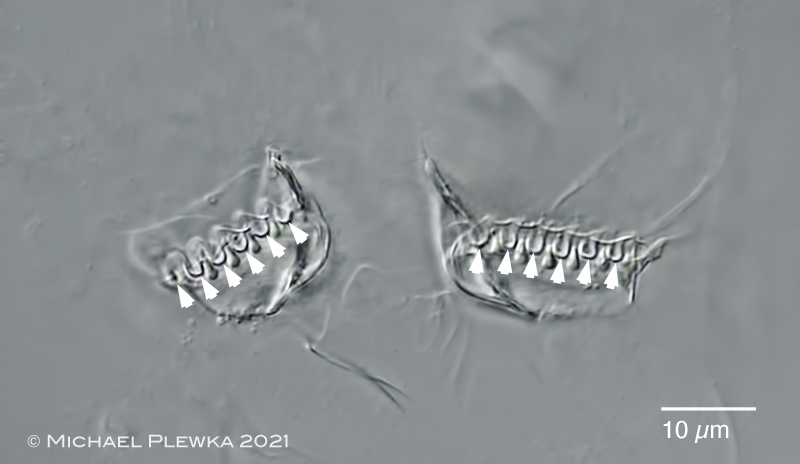 |
| Adineta tuberculosa; by maceration with SDS the basal plates of the rake apparatus with 6 U-hooks (arrowheads) in each become visible. (3) |
| |
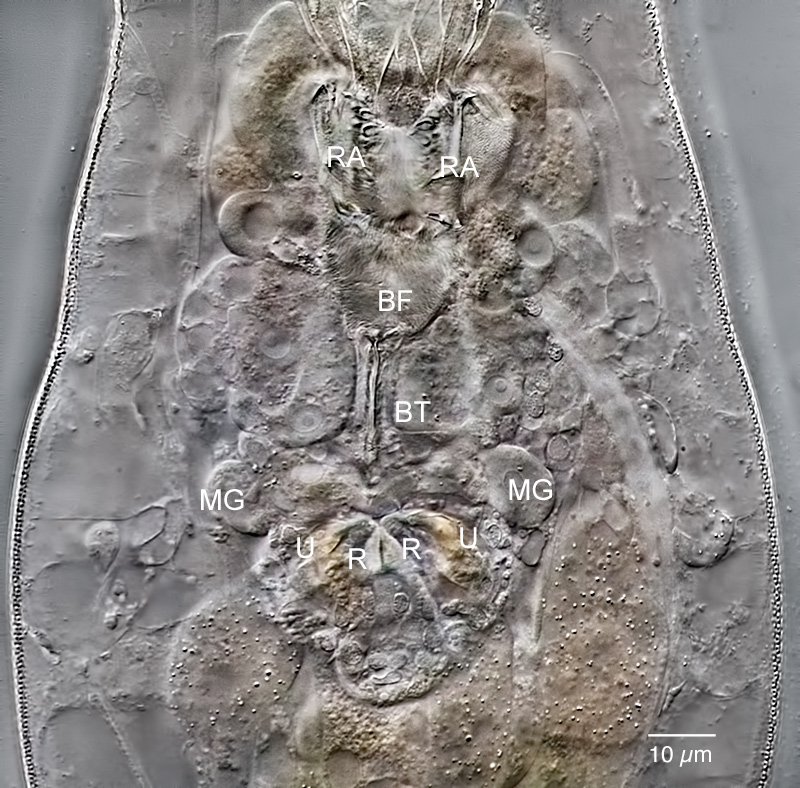 |
| Adineta tuberculosa; anterior part of the intestinal system of a slightly compessed specimen. BF: buccal funnel; BT: buccal tube; MG: mastax glands; R: rami of trophi (the trophi are perpendicular to the plane of the image); RA: Rake apparatus with left and right rake; U: unci. (3) |
| |
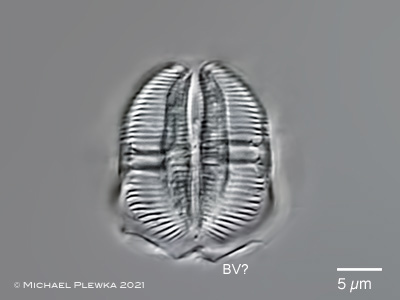 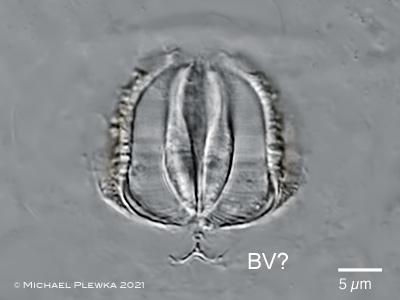 |
| Adineta tuberculosa; two aspects of the ramate trophi with dental formula (DF): 2/2. Left: cephalic view; "BV?" marks a chitinous structure that is visible anterior of the trophi in bdelloid rotifers and which might be the buccal velum. Right image: caudal view; ramus length (RaL): 17µm. (3) |
| |
|
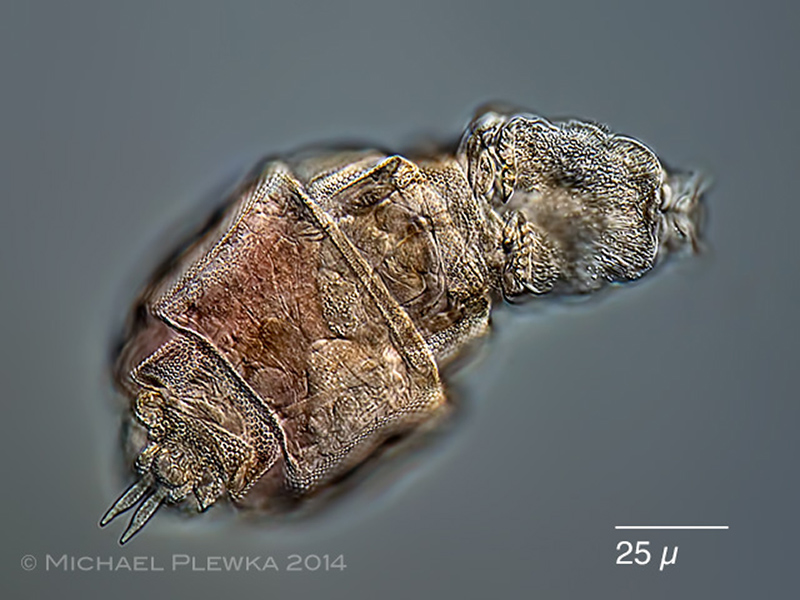 |
| Adineta tuberculosa, while "swimming" the body is contracted. (1) |
| |
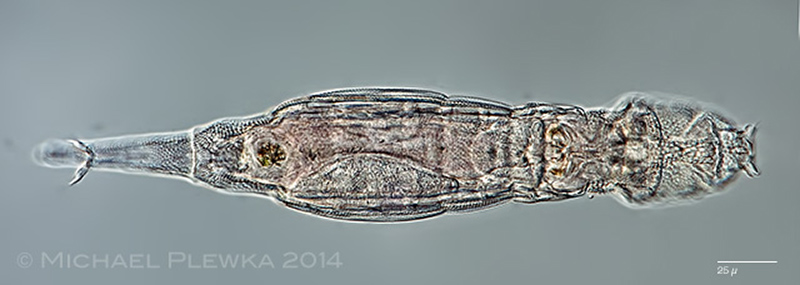 |
| Adineta tuberculosa, another specimen. (1) |
| |
| |
| |
|
|
| Adineta tuberculosa; two aspects of the foot of different specimens. Left: spurs of a creeping specimen with distinct tips. Right: crop of the above image of a swimming specimen; spurs. (1) |
|
| |
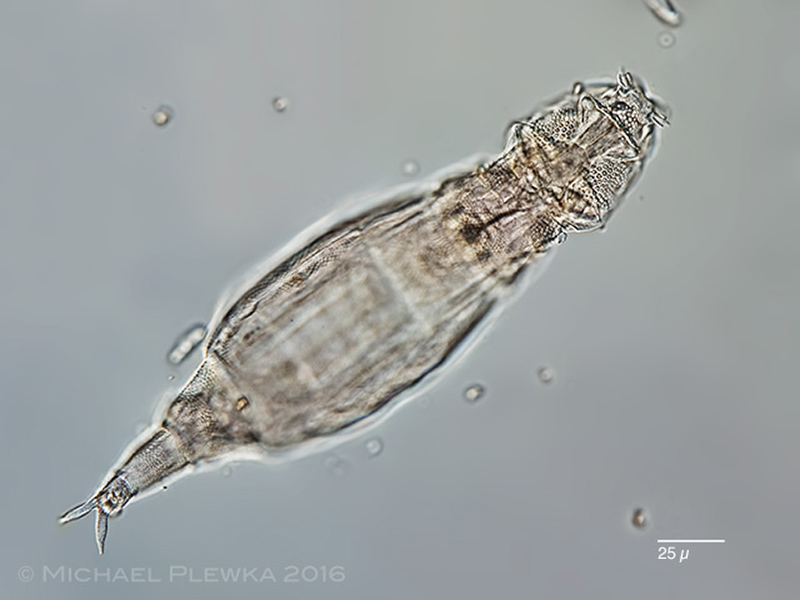 |
| Adineta tuberculosa; specimen from (2) |
| |
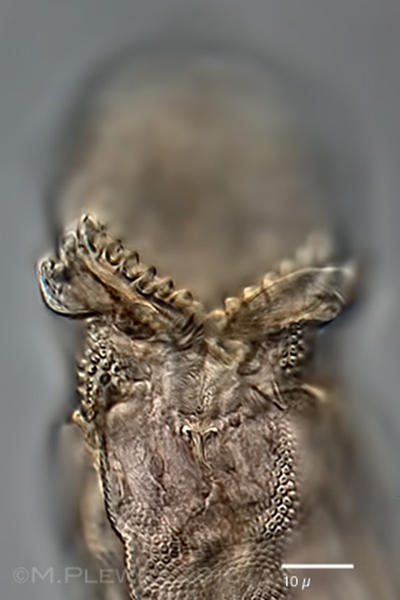 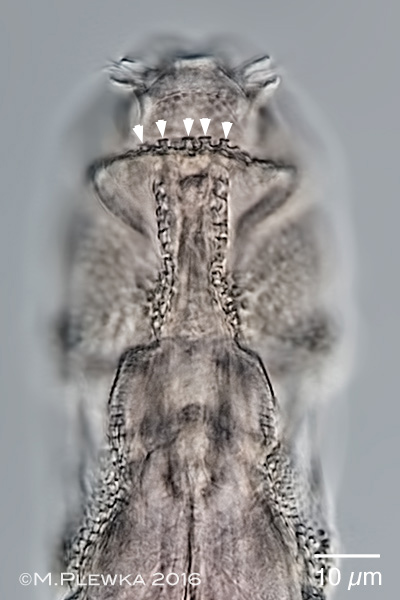 |
| Adineta tuberculosa; two aspects of the head of specimen from (2). Left: ventral view with rake apparatus with 6 U-hooks; right: the arrowheads at the border between head pseudosegment and rostrum point the bollard-shaped outline (optical transect) of the formations of the integument which is especially visible in this area. (2) |
| |
| |
 |
| Adineta tuberculosa; lateral view; the arrow points to the right (inverted U-shaped) side protrusion of the rostral lamella (4) |
| |
| |
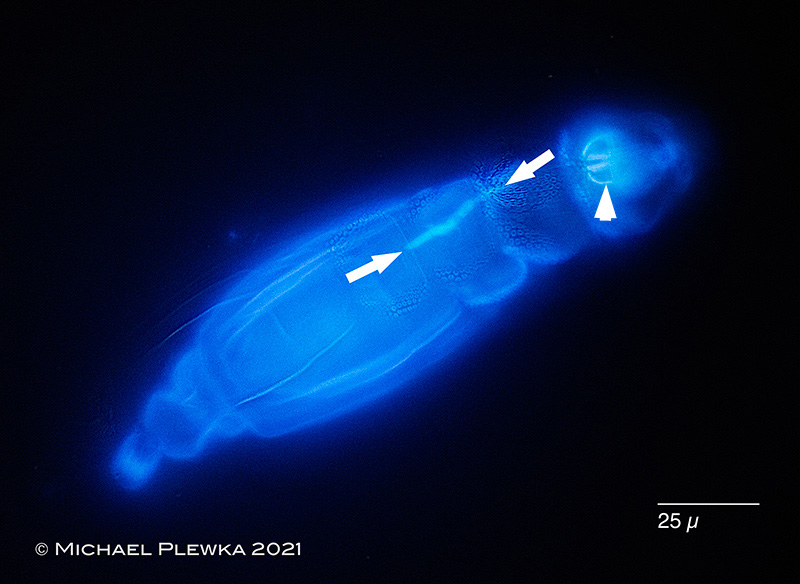 |
| Adineta tuberculosa; fluorescence image (excitation: 395 nm) of specimen stained with Calcofluor White to show the chitinous trophi (arrowhead) and a fungal parasite (marked by two arrows). (3) |
| |
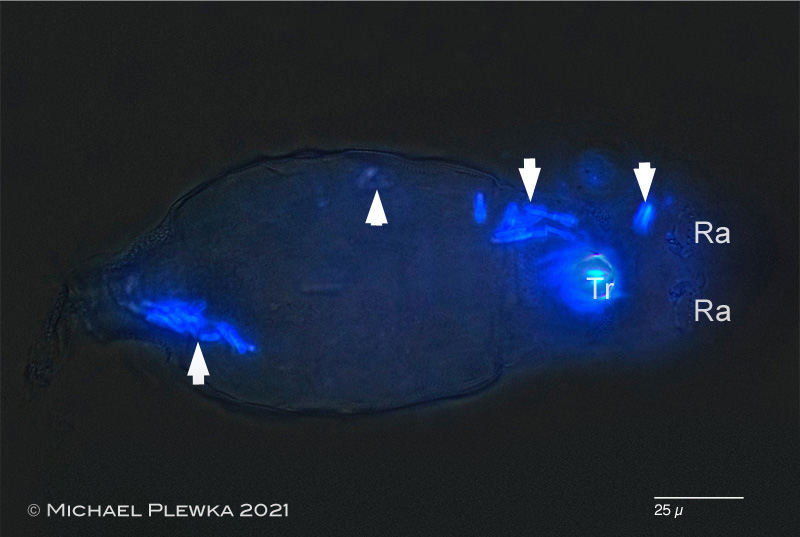 |
| Adineta tuberculosa; another specimen with parasites from the same sample. Arrowheads mark the area of parasites. Ra: rakes; Tr: trophi (3) |
| |
| |
| Collection of sample (3) by courtesy of Dr. Martin Kreutz, realmicrolife. |
| Collection of sample (4) by courtesy of N. Benvenuty; Spain. |
| |
| |
| |
| Location: Speikboden (altitude 2400m), Tauferer Ahrntal, South Tirol, Italy (1); |
| Habitat: dry moss on rocks, (Andreaea rupestris), together with A. vaga var. rhomboidea, Macrotrachela punctata; Pleuretra lineata, Dissotrocha scutellata (1); |
| Date: coll. 7.10.2014, img 25.10.2014.(1); |
| |
| |
|
Location (2): Vesfjellet, Besseggen (1700moh), Norway |
 |
| |
| Habitat (2): dry moss on rocks |
| |
| Date: coll.: 23.07.2016; img: 15.08.2016 (2); |
| |
|
|
|
|
|
| |
| |
|
Location (3): Litzelstetten near Konstanz, BW, Germany. |
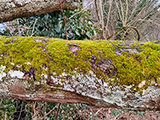 |
| |
| Habitat 3): moss on tree |
| |
| Date: 04.03.2021 (3) |
| |
|
|
|
|
|
| |
| |
|
Location (4): Location: Villa del Rey; Cáceres province; Spain |
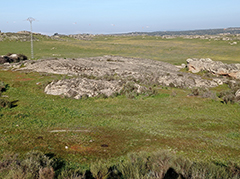 |
| |
| Habitat (4): lithothelma |
| |
| Date: coll.: 01.02.2024; img.: 09.01.2025 (4) |
| |
|
|
|
|
|
| |
| |
|
|
|
|
|
|